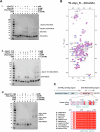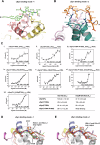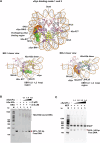Structural and functional insights into the nuclear role of Parkinson's disease-associated α-synuclein as a histone chaperone
- PMID: 40341765
- PMCID: PMC12062221
- DOI: 10.1038/s42003-025-08138-0
Structural and functional insights into the nuclear role of Parkinson's disease-associated α-synuclein as a histone chaperone
Abstract
α-Synuclein (αSyn) plays a critical role in the pathogenesis of 'Synucleinopathies'. Although increased nuclear αSyn localization induces neurotoxicity, its definitive physiological role remains elusive. Previous studies on nuclear αSyn are limited to its interactions with individual histones and dsDNA, leaving a significant gap in understanding its interactions with assembled histone H2a-H2b dimer and (H3-H4)2 tetramer, as well as its role in chromatin regulation. Here, we demonstrate that αSyn binds specifically to both H2a-H2b and (H3-H4)2 with high affinity. Truncation studies reveal that αSyn(1-103) region interacts with (H3-H4)2, while the acidic (121-140) C-terminal end is crucial for H2a-H2b binding and contains a conserved DEF/YxP motif present in other dimer-binding histone chaperones. High-resolution structure of αSyn(121-140) with H2a-H2b complex reveals that αSyn adopts two binding modes (BM-1 and BM-2). Nonetheless, the αSyn C-terminal end in both modes overlap but runs in opposite orientations, specifically interacting with the H2a-L2 and H2b-L1 loop regions of the dimer and cap the H2a-R78 residue. Mutational analysis confirms that αSyn-Y136 and P138 residues, part of the DEF/YxP motif, together with H2a-R78, are critical for αSyn-(H2a-H2b) interaction. The chaperoning assay supports αSyn's function as a histone chaperone, suggesting the potential role of αSyn in the nucleosome assembly/disassembly process.
© 2025. The Author(s).
Conflict of interest statement
Competing interests: The authors declare no competing interests.
Figures







Similar articles
-
Structural Insights into the Association of Hif1 with Histones H2A-H2B Dimer and H3-H4 Tetramer.Structure. 2016 Oct 4;24(10):1810-1820. doi: 10.1016/j.str.2016.08.001. Epub 2016 Sep 8. Structure. 2016. PMID: 27618665
-
DNA repair factor APLF acts as a H2A-H2B histone chaperone through binding its DNA interaction surface.Nucleic Acids Res. 2018 Aug 21;46(14):7138-7152. doi: 10.1093/nar/gky507. Nucleic Acids Res. 2018. PMID: 29905837 Free PMC article.
-
Insights on the nuclear shuttling of H2A-H2B histone chaperones.Nucleosides Nucleotides Nucleic Acids. 2024;43(9):902-914. doi: 10.1080/15257770.2023.2296616. Epub 2023 Dec 22. Nucleosides Nucleotides Nucleic Acids. 2024. PMID: 38133493
-
Mechanistic and structural insights into histone H2A-H2B chaperone in chromatin regulation.Biochem J. 2020 Sep 18;477(17):3367-3386. doi: 10.1042/BCJ20190852. Biochem J. 2020. PMID: 32941645 Review.
-
Structural comparisons reveal diverse binding modes between nucleosome assembly proteins and histones.Epigenetics Chromatin. 2022 May 24;15(1):20. doi: 10.1186/s13072-022-00452-9. Epigenetics Chromatin. 2022. PMID: 35606827 Free PMC article. Review.
References
-
- Goedert, M. Alpha-synuclein and neurodegenerative diseases. Nat. Rev. Neurosci.2, 492–501 (2001). - PubMed
-
- Spillantini, M. G. et al. Alpha-synuclein in Lewy bodies. Nature388, 839–840 (1997). - PubMed
-
- Lashuel, H. A. Do Lewy bodies contain alpha-synuclein fibrils? and Does it matter? A brief history and critical analysis of recent reports. Neurobiol. Dis.141, 104876 (2020). - PubMed
-
- Goers, J. et al. Nuclear localization of alpha-synuclein and its interaction with histones. Biochemistry42, 8465–8471 (2003). - PubMed
MeSH terms
Substances
Grants and funding
LinkOut - more resources
Full Text Sources
Medical
Miscellaneous

